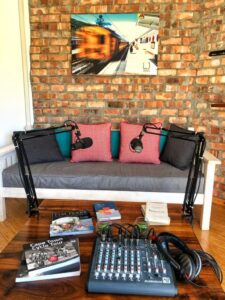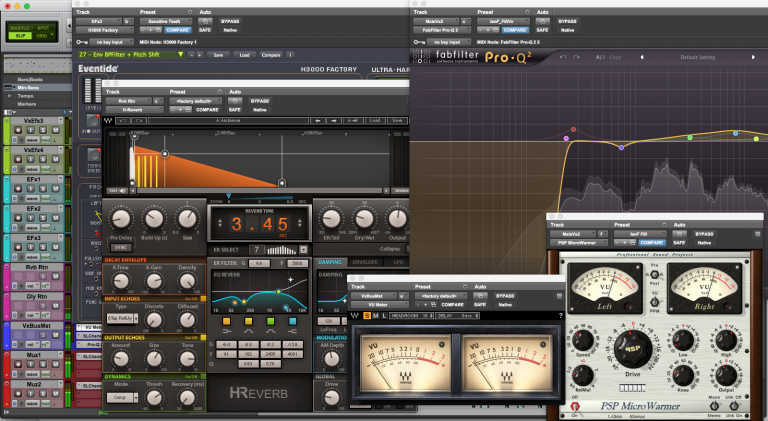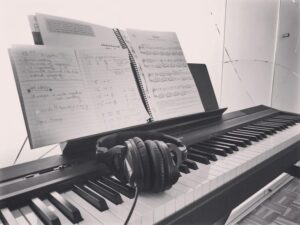
Lindsay Johnson and I go back quite a while. Even if we haven’t met in person, I feel we know each other so well. Crazy what the internet can do! We finally sat down to chat and Lindsay brought some really interesting stuff to the table that I wanted to share with you. Enter Lindsay!
Andreas Sanneman: How has Covid-19 and self isolation changed your world and routines?
Lindsay Johnson: Hey Andy, thanks for having me. It’s a huge honor! COVID-19 lockdown regulations haven’t necessarily changed the way I work. The workload may have slowed down a bit, but as far as working in isolation goes, I’ve been producing from my studio in Cape Town for the last four years and have worked remotely for the majority of the time. So I’m quite used to it already. A lot of commercial radio production in South Africa has come to a halt though, as would be expected, with most businesses freezing their marketing and advertising campaigns. So the industry has taken quite a knock on that front.
My routine has changed though. I have 2 kids and with all our schools being closed during lockdown we have to tackle the school work first thing in the morning. That is quite a challenge, but it needs to be done. If there are urgent recordings that I need to do in the morning then we rearrange the diary, as we need to.
AS: Can you give me a bit of background about yourself, career, and achievements?
LJ: I’ve worked in commercial radio for quite a while. Probably, around 15-16 years. My production path has always been a mixture of radio imaging, sound design, and final mix for post-production. I was never satisfied with just the one. I started working in radio around 2002 for KFM 94.5. In addition to production, that role involved a lot of the technical aspects of broadcasting too – outside broadcasts, marketing events etc. A few years later KFM was taken over by Primedia Broadcasting, which already owned three other stations – 947 and Talk Radio 702 in Johannesburg and Cape Talk in Cape Town. After a number of years at Primedia I left radio to join a post-production house where I was doing sound design and final mix for TV shows, commercials, and documentaries.
When I left the post-house, I relocated to Johannesburg and got back into radio again with Primedia. In Johannesburg I focused primarily on 947 and Talk Radio 702, and helped out on the Cape Town stations when needed. During my five-year period in Johannesburg, I took on the role of Sound Production Manager, which encapsulated production and the on-air sound, so I had one foot in production and another firmly in the technical department. The technical side of things involved everything relating to the transmission path – the most fun part of that for me was being responsible for the overall on-air sound quality for the Johannesburg stations. I spent quite a bit of time tweaking their Optimods and trying to improve their signal chain over the years. Eventually I moved back to Cape Town for family reasons where I joined their Cape Town office again.
A couple months later a new commercial FM broadcast license was awarded in the Cape Town metropole area and I jumped at the opportunity to become part of the start up team at Smile 90.4FM. That’s where you and I had our first interaction, I think? We signed the Benztown Hot AC package at the time. The FM frequency spectrum in South Africa is very limited and it’s not everyday that you get to launch a brand new radio station from the ground up. So it was an opportunity that I couldn’t pass up. My role at Smile 90.4FM was to develop a new AC sound and set it apart from the competitors who had been entrenched in the market for at least 15-20 years already. Of course, the technical tasks weren’t far behind either. While taking care of the imaging and production, I was also responsible for the technical and IT operation for the station. It was quite a lot, but it was a lot of fun too.
After four years in that role, I left Smile 90.4FM to start my own business called Crossfade Studio and built my studio. I’ve been focused on the business for the last four years. I still focus quite a lot of my time on radio imaging as a freelancer and produce multi-station campaigns for commercial brands that advertise on all the major commercial stations across the country. The other half of my time I spend working on audio post-production. Most recently, I’ve jumped on board with Benztown in their custom imaging division and I’ve been having heaps of fun working with Matt Anderson. He’s a great guy and super helpful!
AS: How is it to work for some of the biggest radio brands in SA and worldwide? How do the tasks differ between the different stations / brands? What are the stylistic approaches and how difficult is it to change hats?
LJ: It’s always great hearing your production on air and having the opportunity to be able to influence a part of the station sound, especially since I’m not employed directly by any radio station. In South Africa, there isn’t a lot of outsourcing happening in the imaging and production departments. They mainly keep those tasks for the in-house crew, so I consider myself lucky in that regard to still be able to contribute to the on-air sound. I never take it for granted, no matter what station it’s on. The multi-station campaigns I work on for example, all have to reflect the advertising brand, while maintaining the respective station’s sound. Some stations are “hotter” than others, so to find that groove in the middle and adapt what you need to for each of the stations is all part of the creative fun and making the campaign work. I like working on a variety of formats, even though I’m better at some and not others. That’s why I’m enjoying producing for Benztown right now. There are various formats, so it keeps me challenged. But for me, less is always more. I think there’s a fine line between producing for you and producing for a listener. So you have to strike a good balance between production wizardry and the message to the listener.

AS: What do your days look like? Is there a blueprint? A routine?
LJ: No blueprint at all, other than the daily school work during the COVID pandemic! Because I’m self-employed and work on all types of audio production, it can be anything on any day. There’s a good balance between radio and post-production. I take it as it comes. And well yes, there are days when I’m not doing any production. On those days I try and get the admin work done and I sneak in a cold beer when I can. The sun on the African continent is hot, you need to quench that thirst!
AS: What is your most memorable project?
LJ: I have 2. The first one was launching Smile 90.4FM. It was great to be part of something new that reached a wide range of audiences and be able to influence their sound. The other was starting my business and building the studio. It was a long-term plan that I always kept my eye on and I’m really grateful that I got to follow through with it. I don’t regret a single moment of it.
AS: How is the SA radio market different from others?
LJ: My answer to this question would probably be quite different to when I actively worked at a radio station. But I think I’m back down to consuming radio as a listener again. Enjoying the medium as a whole and not trying to dissect every hour, which is what most of us do, I think. I prefer it this way to be honest. I think it informs my production approach…and that is to get out of the way of the message, but still be creative and draw their attention. Even though I have my favorite station, I still flip through the frequency band regularly to hear what’s going on. I think it would be fair to say that the SA radio market is relatively conservative. It’s dominated by a lot of AC and Hot AC format stations, so their music playlists are more or less the same in whatever province you happen to be in. I’m sure there’ll be people who would disagree, but that’s just my opinion. There are a few unique sounding stations to the SA market though, these stations usually give a lot of focus to the local music market. The vernacular stations in South Africa probably have the most listenership figures – easily a good couple million and those are not necessarily your mainstream AC/Hot AC stations.
You and I have had this discussion before, but as far as writing copy is concerned, the imaging team very seldom writes the copy too. Most stations have a dedicated writing team to handle copy and sometimes you can find a slight disconnect between the production and the writing. That’s the one thing I’ve noticed about the setup of production departments elsewhere around the world…the imaging person is also the creative writer. I prefer that approach. I think it lends itself to being more creative in your imaging.
AS: What DAW do you use?
LJ: It’s always been Pro Tools. I know it has its glitches, but it works for me. I’ll use NI’s Maschine and the Maschine Studio controller when I need to cook up sound design or if I’m working on a beat or music cue. I like that it’s all integrated with the hardware controller so I can keep my eyes and ears focused on the sound I’m producing and drop the mouse for a bit. I’m not a big fan of setting up MIDI maps and assigning parameters to controllers and all that – it takes up too much time. I like to get onto the task immediately.
AS: What are your favorite plugins?
LJ: I think monitoring your levels is very important from start to finish, so you’re going to find Waves’ VU meter plugin on every Aux Bus and Master Fader.
I can’t live without PSP’s micro warmer on vocal channels. It gives it a nice boost and presence.
ProQ2 – the user interface makes it super easy and straightforward to carve out a sound.
SSL Channel Strip – I like the character and colour it adds. Sometimes just adding some of it’s top-end is enough.
H-Reverb or Eventide’s Ultraverb
SoundToys’ Alter Boy and Echoboy
And recently I’m quite enjoying NI’s Raum reverb plugin.

AS: What are new learnings? Inspirations?
LJ: I started going to formal piano lessons close to 2 years ago. So I’ve been focusing a lot of my spare time on getting ahead in that. I’ve made excuses for years not to, but eventually just got my ass into gear and got on with it. I know a lot of people would probably say you don’t need music theory to get ahead, but it’s a personal goal and achievement of mine. I also love watching the Masterclass videos online. I watch a range of topics and I think you can learn quite a lot from those professionals. The Masterclass on Space Exploration was really inspirational in that hard work, dedication, and focus will yield results.

AS: Any new tools you discovered lately?
LJ: I love the Native Instruments and Heavyocity products. None of it is overly new, but I just love the sounds and textures those companies produce.
AS: Your favorite piece of imaging / production ever?
LJ: Many years ago in an edition of RAP Mag they featured a piece by Jerry Rohira. I think he was working at SiriusXM at the time, based in New York. It was an imaging piece describing what radio imaging is to a “normal” person without all the radio jargon. It was really well written and superbly produced by Jerry. I still find it valid today. It really paints a picture for the listener and demonstrates how you’re able to tell a story and be creative using audio production. I still have that audio all these years later. It’s a great piece!
AS: Who have been mentors of yours and how did they support you?
LJ: There have been a few over the years. The first and most important is my wife! She’s really the voice of reason in my life. Always being objective about things and giving me alternatives to think about. The next one I’d have to say is the guy who first employed me at KFM – Jaco Viljoen. He’s given me tons of advice and guidance over the years. Nearly 20 years on we still remain great friends! The other guy who really had a great influence on my imaging is Brendan Taylor, who is now at the Nova Group in Sydney. At the time Brendan was part of the consulting team for KFM and made a few trips over to Cape Town over the years. We had a lot of group production sessions with the programming and creative departments. Chris Thorpe in London, who was also part of the consulting team and Mitch Callendine too. The common thread with Brendan, Chris, and Mitch is that I made them all drink the worst rum shooter you can find in Cape Town when they visited. I’d do the same to you, too, if you were to visit Cape Town! I also have to add a very good friend and client of mine – Cameron Naidoo. He runs a successful creative agency and he’s given me tons of business and entrepreneurial advice over the years.
AS: The best tech purchase under a hundred dollars?
LJ: I have to say it’s probably Izotope’s Music Maker Bundle for a sale price of $49. I’m not overly crazy about the Izotope plugins (except for RX), but you can’t beat what you’re getting in that bundle. I picked it up myself!
AS: If you had to pick five plugins, what would they be?
LJ: Waves H-Reverb, EchoBoy, PSP Micro Warmer, C6 Multiband, and L2 Ultramaximizer.
AS: What gear would your dream studio have?
LJ: Avid S3 or S4, plus an Avid Dock and Dolby Atmos with Adam Audio monitoring in a theatre-sized mix room.
AS: Who or what inspires you?
LJ: I love being outdoors. Getting away for a weekend always resets my brain and outlook on life. We’re very spoilt for choice in Cape Town with getaway options. I love information, too. I’m not a big reader of novels, but I always try and soak up new and varied information – hence me spending a lot of time on the Internet. But the big inspiration is always music. I really try to be open to all genres of music. In some way I’m sure it influences my style of production.
AS: What’s the best advice you’ve ever been given?
LJ: Never burn your bridges. It’s a small world and an even smaller industry. Most of the people I work with on a regular basis are folks who I have a long relationship with. We’ve built up a lot of trust over the years. Word of mouth recommendations are priceless.




